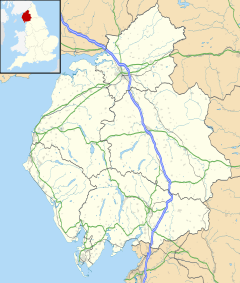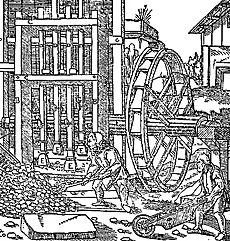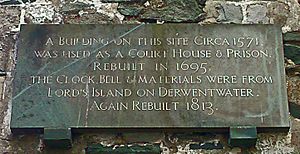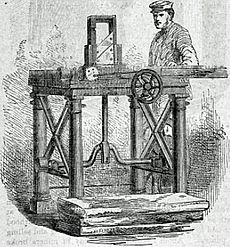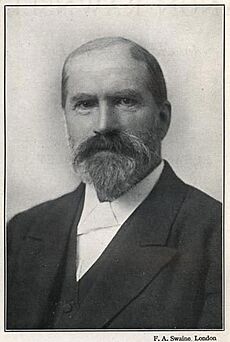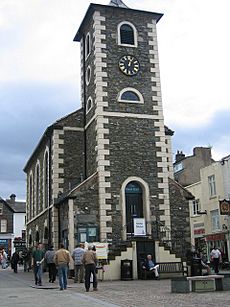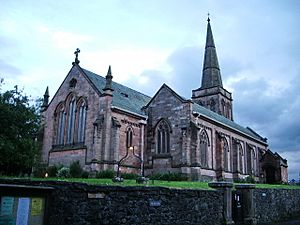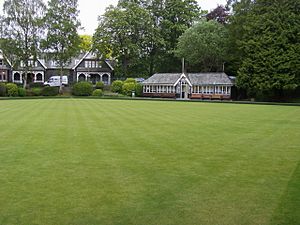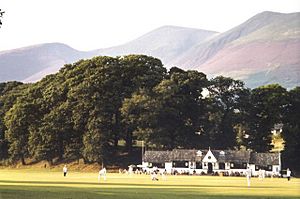Keswick, Cumbria facts for kids
Quick facts for kids Keswick |
|
|---|---|
|
|
|
| Population | 5,243 (2011) |
| OS grid reference | NY270233 |
| Civil parish |
|
| Unitary authority |
|
| Ceremonial county | |
| Region | |
| Country | England |
| Sovereign state | United Kingdom |
| Post town | KESWICK |
| Postcode district | CA12 |
| Dialling code | 017687 |
| Police | Cumbria |
| Fire | Cumbria |
| Ambulance | North West |
| EU Parliament | North West England |
| UK Parliament |
|
Keswick (/ˈkɛzɪk/ KEZ-ik) is a lively market town and civil parish in the Cumberland area of Cumbria, England. It's located inside the beautiful Lake District National Park, just north of Derwentwater and about 4 km from Bassenthwaite Lake. In 2011, the town had a population of 5,243 people.
People have lived in the Keswick area since ancient times. The town was first officially mentioned in the 13th century. That's when King Edward I of England gave Keswick the right to hold a market. This market has been running for over 700 years without stopping!
Keswick was once important for mining. But since the 1700s, it has become famous as a holiday spot. Tourism has been its main industry for more than 150 years. Some cool places to visit include the Moot Hall, the modern Theatre by the Lake, the Alhambra cinema (one of Britain's oldest!), and the Keswick Museum and Art Gallery in Fitz Park. Keswick also hosts the Keswick Convention every year, which is a big gathering for Christians from many countries.
Keswick is well-known because of its connections to famous poets like Samuel Taylor Coleridge and Robert Southey. They were part of the "Lake Poets" group, along with William Wordsworth (who lived nearby in Grasmere). These poets helped make the stunning beauty of the Lake District famous to people everywhere. Later, in the late 1800s and early 1900s, Keswick became a center for the conservation movement. People like Hardwicke Rawnsley, who helped start the National Trust, worked to protect the natural beauty of the area.
Contents
What's in a Name?
The name "Keswick" first appeared in King Edward I's charter in the 13th century as "Kesewik". Many experts believe the name comes from an old English phrase meaning "farm where cheese is made." The word "cēse" means cheese, and "wīc" means a special place or dwelling.
However, not everyone agrees. Some scholars think the name might be Danish or Norse (from Vikings) because Keswick was in an area settled by Vikings. They suggest it could mean "Kell's place at the bend of the river." But the "cheese farm" idea is still the most widely accepted.
A Look Back in Time
Ancient History
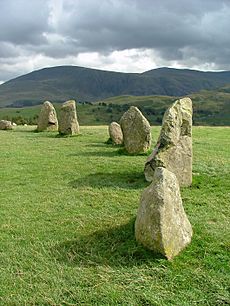
You can find signs of people living in the Keswick area a very long time ago! The Castlerigg stone circle, just outside town, is about 5,200 years old (around 3200 BC). Stone tools from the Stone Age have been found inside the circle and in Keswick itself. This shows that Stone Age people felt right at home in the Lake District.
There isn't much proof of people living here all the time during the Bronze Age. But from old hill forts, we know that people lived here during the Iron Age (around 500 BC).
During the time of Roman Britain, the area was important because of Hadrian's Wall. While there's no sign of a Roman town in Keswick, some finds suggest Roman roads passed nearby. Many local place names, like the River Derwent, are Celtic, which is an old language.
Later, in the late 500s and early 600s AD, Christian saints like St Herbert and St Kentigern preached in the area. St Herbert lived as a hermit on an island in Derwentwater, which is now named after him. St Kentigern is believed to have founded Crosthwaite Parish Church, which was Keswick's main church for a long time.
The Middle Ages
Keswick's recorded history really begins in the Middle Ages. The area was taken over by the Anglo-Saxon Kingdom of Northumbria in the 600s. But then Vikings destroyed Northumbria in the late 800s. In the early 900s, the British Kingdom of Strathclyde took control.
In 1181, a new church was built at Crosthwaite, near Keswick. Later, in 1189, King Richard I gave the church to the Cistercian monks of Fountains Abbey.
During the 1200s, two large abbeys, Fountains and Furness, bought a lot of farmland around Keswick. They wanted to raise more sheep for wool. Keswick became a central point for these farms. The monks also had rights to mine iron ore.
King Edward I officially granted Keswick its market charter in 1276. This market has continued without a break for over 700 years! The buildings around the market square looked much the same from this time until the late 1700s. People say the strong walls and narrow entrances to yards were for defense against Scottish raiders. Luckily, it seems Keswick avoided these attacks.
1500s and 1600s: Farming and Industry
When the Dissolution of the Monasteries happened (1536-1541), new landowners took over from the abbeys. This made Keswick even more important as a market town for buying and selling sheep and wool. At first, Keswick was still a small, simple market town.
But by the late 1500s, copper mining made Keswick richer. Queen Elizabeth I needed a lot of copper for weapons and warships. She hired German mining experts, like Daniel Hechstetter, to find and dig for copper in the Keswick area.
Besides copper, a new material called graphite was found. It had many uses: it made machines run smoother, helped make heat-resistant pots, and even made cannonballs rounder! Later, from the late 1700s, graphite was used to make pencils, which Keswick became famous for.
The copper mines did well for about 70 years. But by the early 1600s, the industry slowed down. Graphite mining continued, and quarrying for slate became more important. Other small businesses, like tanning leather and weaving, also grew. Even though the mining boom ended, Keswick's economy stayed steady.
1700s and 1800s: The Start of Tourism

People like John Dalton and John Brown are seen as the first tourists in the Lake District. They wrote about the amazing scenery, which made others want to visit. The poet Thomas Gray visited Keswick in 1769 and wrote about its beauty. His writings were very popular and helped promote Keswick. Painters also created pictures of the area, which made it even more famous.
By 1800, the famous poet Samuel Taylor Coleridge moved to Keswick. He and other "Lake Poets" helped make the Lake District, and Keswick, very popular.
During the 1700s and 1800s, roads in Cumberland got much better. This made it easier for wealthy visitors to reach the Lake District by coach. Regular coach services started in the 1760s. Even though it was expensive, many tourists came. By the 1800s, about 12,000 to 15,000 tourists visited Keswick each year. Some of the old inns that served these visitors are still hotels today.
The arrival of railways in the mid-1800s made Keswick even more accessible. The Cockermouth, Keswick and Penrith Railway (CKP) line was built to transport iron ore and coal. It opened for goods in 1864 and for passengers in 1865. This meant more people, including those with less money, could visit Keswick.
Keswick also became known for making pencils in the 1800s. It started small, using local graphite. Then, factories were built, and pencil making became the town's most important manufacturing industry.
The Moot Hall was rebuilt in 1813. Gas lighting came to town in 1846, a library opened in 1849, and a police station in 1857. The local newspaper, The Keswick Reminder, started in 1896 and is still published every Friday.
In 1883, Hardwicke Rawnsley became the vicar of Crosthwaite. He had a huge impact on Keswick. He and his wife started classes to teach metalwork and wood carving, which became the Keswick School of Industrial Art. He also helped start Keswick School and was a co-founder of the National Trust. The National Trust bought many beautiful areas around Derwentwater, helping to protect them for everyone to enjoy.
20th Century and Today
Throughout the 1900s, Keswick relied more and more on tourism. The pencil industry was the second biggest employer. The Cumberland Pencil Company had a large factory in Keswick until 2006. Now, only the Derwent Pencil Museum remains at the old site.
The Lake District National Park was created in 1951. This park has strict rules about new buildings, which has kept Keswick from expanding too much. Keswick's population has stayed around 5,000 people.
Today, most people in Keswick work in hotels, restaurants, and shops. Many shops sell outdoor clothes, and there are lots of cafes and gift shops. The population of Keswick is generally older than the average for England.
How Keswick is Governed
Keswick became a local government district in 1853. In 1974, the town became part of the Allerdale Borough Council. Today, Keswick is managed by the Keswick Town Council and the Cumberland Council.
Since 2024, Keswick has been part of the Penrith and Solway area for the UK Parliament.
Geography and Climate
Keswick is in the northern part of the Lake District in northwest England. It's about 31.5 km southwest of Carlisle and 22 km northwest of Windermere. Derwentwater, the lake southwest of town, is about 3 km long and 1 km wide, and about 22 m deep. It has several islands, including Derwent Isle, which is the only one where people live. The River Derwent flows from Derwentwater to Bassenthwaite, the most northern of the big Cumbrian lakes. The Derwent and its smaller river, the Greta (which flows through Keswick), meet near Portinscale.
Keswick is protected by the Skiddaw mountains, which are the oldest rocks in the Lake District. These mountains formed over 400 million years ago and reach a height of 931 m at Skiddaw itself. To the east, you can find the Castlerigg stone circle and the Helvellyn range, which is popular for hiking.
Keswick has cool summers, mild winters, and a lot of rain throughout the year. The wettest months are usually at the end of the year, with October getting the most rain.
| Climate data for Keswick (1991–2020 averages) | |||||||||||||
|---|---|---|---|---|---|---|---|---|---|---|---|---|---|
| Month | Jan | Feb | Mar | Apr | May | Jun | Jul | Aug | Sep | Oct | Nov | Dec | Year |
| Mean daily maximum °C (°F) | 7.4 (45.3) |
7.8 (46.0) |
9.7 (49.5) |
12.4 (54.3) |
15.8 (60.4) |
18.2 (64.8) |
19.8 (67.6) |
19.2 (66.6) |
17.0 (62.6) |
13.5 (56.3) |
10.0 (50.0) |
7.8 (46.0) |
13.2 (55.8) |
| Daily mean °C (°F) | 4.7 (40.5) |
4.8 (40.6) |
6.3 (43.3) |
8.4 (47.1) |
11.3 (52.3) |
14.0 (57.2) |
15.7 (60.3) |
15.3 (59.5) |
13.2 (55.8) |
10.2 (50.4) |
7.1 (44.8) |
4.9 (40.8) |
9.7 (49.4) |
| Mean daily minimum °C (°F) | 2.0 (35.6) |
1.8 (35.2) |
2.8 (37.0) |
4.4 (39.9) |
6.8 (44.2) |
9.7 (49.5) |
11.6 (52.9) |
11.4 (52.5) |
9.4 (48.9) |
6.8 (44.2) |
4.2 (39.6) |
1.9 (35.4) |
6.1 (43.0) |
| Average precipitation mm (inches) | 172.5 (6.79) |
135.4 (5.33) |
114.9 (4.52) |
82.8 (3.26) |
81.6 (3.21) |
89.9 (3.54) |
94.9 (3.74) |
120.2 (4.73) |
124.4 (4.90) |
175.0 (6.89) |
188.6 (7.43) |
195.2 (7.69) |
1,575.4 (62.03) |
| Average precipitation days (≥ 1 mm) | 16.8 | 14.3 | 14.1 | 12.5 | 12.4 | 12.7 | 13.5 | 15.2 | 13.5 | 17.0 | 18.2 | 17.8 | 178 |
| Source: UK Met Office | |||||||||||||
Population Changes
In 1801, the town of Keswick and its nearby areas had about 1,350 people. The population steadily grew, reaching 2,618 by 1851. By 1901, it was 4,451. Since then, the population has stayed quite stable, with 4,821 people in 2011.
In 2021, most people in Keswick identified as Christian (54.3%). A large number (37.8%) said they had no religion.
Famous Landmarks
Keswick is home to the Theatre by the Lake, which opened in 1999. It's a modern theatre that hosts professional plays and visiting shows. The Alhambra cinema, opened in 1913, is one of the oldest cinemas in the country that's still running. It even shows live plays and operas from famous venues!
You can also visit the Derwent Pencil Museum. One of its cool exhibits is said to be the world's largest colored pencil! Fitz Park, by the River Greta, has the Keswick Museum and Art Gallery. This Victorian museum has interesting items like the "Musical Stones of Skiddaw" and paintings by famous artists. In 2001, the cricket ground in Fitz Park was named the most beautiful in England!
Greta Hall is a very old and important building. It was the home of poet Samuel Taylor Coleridge (1800-1804) and then Robert Southey (1803-1843). Many other famous writers visited them there. The Moot Hall is another important building in the town center. It was built in 1571 and rebuilt several times, with the current building from 1813. It has a unique one-handed clock! The ground floor is now a tourist information center, and there's an art gallery upstairs.
John Ruskin, a famous thinker and art critic, is remembered with a memorial at Friars' Crag. It was put up in 1900 and is a protected structure.
Churches in Keswick
Until 1838, Keswick didn't have its own Anglican church. It was part of the larger Crosthwaite parish. The current main church, St John's, was designed by Anthony Salvin and opened in 1838. It's a beautiful church with pink sandstone and a slate roof.
Keswick's older parish church, St Kentigern's, is just outside town. It dates back to at least the 1300s.
Other churches in Keswick include a Congregational chapel built in 1858-59, and the current Methodist church in Southey Street. Roman Catholics have been served by Our Lady of the Lakes and St Charles since 1928. A new Quaker meeting house opened in 1994.
Places to Eat and Stay
Keswick has many old inns and hotels, some of which are very historic. The George Hotel is said to be the oldest inn in town, dating back to the 1500s. The King's Arms Hotel, in the main market square, is from the early 1800s. The Bank Tavern and the Dog and Gun pub are also old buildings from the 1700s.
Many buildings in Keswick are listed as historic, meaning they are protected. Here are some of them:
- 10–15, Borrowdale Road (Grade II)
- 123 and 125, Main Street (Grade II)
- 17–23, St John's Street (Grade II)
- 18, High Hill (Grade II)
- 2, Eskin Street (Grade II)
- 25, St John's Street (Grade II)
- 3, Penrith Road (Grade II)
- 3–6, High Hill (Grade II)
- 36–50, St John's Street (Grade II)
- 4 and 6, Derwent Street (Grade II)
- 4 and 6, Eskin Street (Grade II)
- 6–12, Police Station Court (Grade II)
- 8 and 10, Eskin Street (Grade II)
- 85–91, Main Street (Grade II)
- Balustrading, Urns, and Terrace Wall to Garden on North Side of Castlerigg Manor (Grade II)
- Brigham Forge Cottages (Grade II)
- Calvert's Bridge (Grade II)
- Castlerigg Manor (Catholic Youth Centre) (Grade II)
- Castlerigg Manor Lodge (Grade II)
- Central Hotel (Grade II)
- Chestnut Hill House Shelley Cottage with Adjoining Stables and Coach House to North (Grade II)
- Church of St John (Grade II*)
- Church of St Kentigern (Grade II*)
- County Hotel (Grade II)
- Crosthwaite Sunday School (Grade II)
- Crosthwaite Vicarage (Grade II)
- Derwent Isle House (Grade II)
- Forge Bridge (Grade II)
- Formerly Mayson's Shop (Grade II)
- George Hotel (Grade II)
- Greta House (Grade I)
- Heads House (Grade II)
- Ivy Cottage (Grade II)
- Keswick Industrial Arts (Grade II)
- Keswick Railway Station Building and Platform (Grade II)
- King's Arms Hotel (Grade II)
- Oak Cottage Oak Lodge (Grade II)
- Oddfellows Arms Public House (Grade II)
- Packhorse Inn Including Attached Former Stables (Grade II)
- Police Station and Magistrates Court (Grade II)
- Priorholm Hotel (Grade II)
- Royal Oak Hotel (Grade II)
- Ruskin Monument (Grade II)
- Skiddaw Cottage (Grade II)
- Small Outbuilding Opposite Packhorse Inn and Behind Ye Olde Friars (Grade II)
- The Bank Tavern (Grade II)
- The Dog and Gun Public House (Grade II)
- The Moot Hall (Grade II*)
- The Old Chapel at Landing Stage (Grade II)
- Toll Bar Cottage (Grade II)
Sports and Activities
Keswick is home to many sports clubs!
- Football: Keswick Football Club has teams for men, women, and juniors (under-16, under-14, under-12, and under-10).
- Rugby: Keswick Rugby Union Football Club started in 1879 and has several teams. They also help organize the Keswick Half Marathon.
- Tennis: Keswick Tennis Club has grass and hard courts in Fitz Park.
- Cricket: Keswick Cricket Club, started in the 1880s, has senior and junior teams, plus a women's team.
- Bowls: Keswick Fitz Park Bowls Club was founded in 1882.
- Other Sports: You can also find Keswick Croquet Club, Keswick Archers, and a junior badminton club.
The Keswick Leisure Pool and Fitness Centre has a pool and fitness equipment, and even offers canoeing lessons.
Getting Around Keswick
Keswick is on the A66 road, which connects Workington and Penrith. It's also on the A591, linking it to Windermere, Kendal, and Carlisle.
There are no train lines to Keswick anymore. The old railway line closed in 1972. There are plans to rebuild it, but it would be very expensive. Today, you can take a bus from the main train station in Penrith to Keswick, which takes about 47 minutes.
Buses also connect Keswick to other towns and villages in the northwest. A bypass was built in 1974 to help traffic flow better around the town.
Most visitors come by car. There are several car parks in the town center and near the Theatre by the Lake.
Media and News
For local TV, Keswick gets news from BBC North East and Cumbria and ITV Border. You can listen to local radio stations like BBC Radio Cumbria and Smooth Lake District. There's also a community radio station called Lake District Radio online.
Local newspapers include The Keswick Reminder and Westmorland Gazette.
Culture and Events
Fun Events All Year Round
Keswick has many exciting events throughout the year!
- Keswick Film Festival: In February-March, you can watch old and new films, and see short films by local moviemakers.
- Words by the Water: This literary festival happens every March at the Theatre by the Lake. Famous writers and speakers come to share their ideas.

- May Events:
* The Keswick Half Marathon takes runners around Derwentwater. * The Keswick Jazz Festival is a four-day event with over 100 jazz performances. * The Keswick Mountain Festival celebrates outdoor activities like mountain biking, hiking, canoeing, and climbing.
- Keswick Beer Festival: In June, this two-day event attracts thousands of people.
- Keswick Convention: In July and August, this is a big international gathering for Christians.
- August Events:
* The Derwentwater Regatta is a fun weekend of boat races and activities on the lake. * The Keswick Agricultural Show, started in 1860, features farm animals, local products, and competitions.
You can also enjoy classical music throughout the year, with performances by the Keswick Choral Society and the Keswick Music Society.
Famous People from Keswick
The poets Samuel Taylor Coleridge and William Wordsworth were close friends. When Wordsworth moved to the Lake District, Coleridge followed, leasing Greta Hall in Keswick. Later, Robert Southey, Coleridge's brother-in-law, shared the house and lived there until he died in 1843. Many famous writers visited Greta Hall, including Charles and Mary Lamb, Thomas de Quincey, and Sir Walter Scott. These visitors wrote about the beautiful scenery, which made the area even more popular. Southey is buried in Crosthwaite churchyard.
Before the Lake Poets, Sir John Bankes was a notable person from Keswick. He was a leading Royalist during the English Civil War and a top judge for King Charles I. He was born near Keswick in 1589.
Later, Frederic Myers, a scholar and poet, was born in Keswick. Donald Watson, who started the Vegan Society, lived in Keswick after he retired. The famous mountaineers and photographers George and Ashley Abraham also lived and worked in Keswick. Their old photo shop is now a mountaineering store, but it still has their old photos.
The novelist Hugh Walpole also had a strong connection to Keswick. He moved to a house near Derwentwater in 1924. He loved Cumberland and often wrote about its scenery and atmosphere in his books.
See also
 In Spanish: Keswick para niños
In Spanish: Keswick para niños







